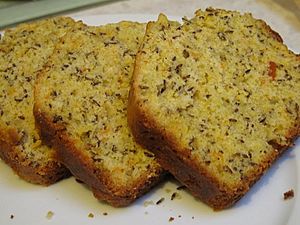Caraway seed cake facts for kids
 |
|
| Type | Cake |
|---|---|
| Place of origin | United Kingdom |
| Main ingredients | Flour, eggs, caraway seeds |
Seed cake is a classic British cake. It gets its special taste from caraway seeds or other flavorful seeds. People in Britain have used caraway seeds in cooking for a long time.
In the past, special caraway-seed biscuits were made to celebrate the end of planting spring wheat. Over time, these biscuits changed into the delicious tea cake we know today as seed cake.
History of Seed Cake
Seed cake has a long and interesting history. Recipes for this cake can be found in very old cookbooks. Some of the earliest recipes appeared in books like A.W.'s Book of Cookrye (1591) and The English Huswife by Gervase Markham (1615).
This cake was very popular in the 1700s and throughout the Victorian era. Many famous cookbook writers included seed cake recipes in their books. For example, Hannah Glasse shared recipes for both a "cheap seed-cake" and a "rich seed-cake" in her book The Art of Cookery Made Plain and Easy (1747).
Other well-known authors like Elizabeth Moxon (1764), Amelia Simmons (1796), Mary Eaton (1822), and Isabella Beeton (1861) also featured seed cake in their popular cookbooks.
Caraway vs. Seed Cake
Sometimes, "seed cake" and "caraway cake" are slightly different. Old cookbooks often had separate recipes for each. For example, Elizabeth Moxon's 1764 cookbook included distinct recipes for "carraway cake" and "seed cake."
Caraway seeds were a very popular flavor. They were used in many different cakes and biscuits. This shows how much people enjoyed the unique taste of caraway.
Where Seed Cake is Popular
Seed cake was not only popular in England. It was also a favorite treat in Ireland and Wales.
You might also hear about Goosnargh Cake. This is a type of biscuit or cake named after a village in Lancashire, England. It also often features caraway seeds.
See also
 In Spanish: Pastel de semilla de alcaravea para niños
In Spanish: Pastel de semilla de alcaravea para niños

